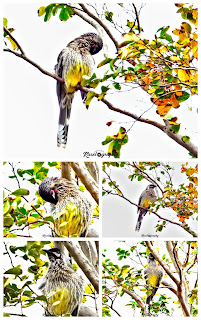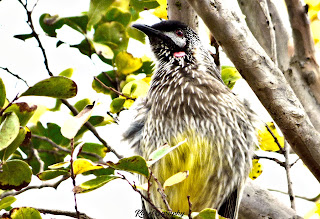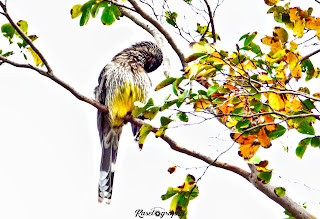Red Wattlebirds, Anthochaera carunculata
Posted at 14th- Sep- 2020 Time 01: 19 pm
Views 8864 times

Red Wattlebirds, Anthochaera carunculata
[Device used: Panasonic Lumix DMC FZ-70; Pakenham, Victoria, Australia; APRIL/2020]
I saw this bird sitting on our crepe myrtle, didn't know what type of bird this was. took this picture from very far away, was sitting on the top branch on the tree.
Pictures are not very sharp though. Still trying to get one good shot of this bird.
[Device used: Panasonic Lumix DMC FZ-70; Pakenham, Victoria, Australia; APRIL/2020]
Red Wattlebirds, Anthochaera carunculata, are large honeyeaters easily identified by their fleshy reddish wattle on the side of the neck.
They live across southern Australia and are very frequent visitors to gardens in urban areas. They eat mostly nectar but also some insects and can be very aggressive towards other birds that have their eye on the same flowers.
[Device used: Panasonic Lumix DMC FZ-70; Pakenham, Victoria, Australia; APRIL/2020]
In winter Red Wattlebirds are more frequent visitors to towns and suburbs, where you'll have a much easier time spotting them.
Red Wattlebirds migrate in search of winter food. They love to drink the nectar from flowers in your local parks and gardens, as they are part of the Honeyeater family. [1]
[Device used: Panasonic Lumix DMC FZ-70; Pakenham, Victoria, Australia; APRIL/2020]
The Red Wattlebird is the second largest honeyeater in Australia (the Tasmanian Yellow Wattlebird is the largest). They can display domineering and often aggressive behaviour towards other birds intruding on their territory.
The Red Wattlebird is a large, noisy honeyeater. The common name refers to the fleshy reddish wattle on the side of the neck. The plumage is grey-brown on the body, with prominent white streaks and yellow on the belly. The face is pale and the tail is long with a white-tip. Young Red Wattlebirds are duller than the adult and have a brown, rather than reddish, eye. The wattle is also very small and pale.
[Device used: Panasonic Lumix DMC FZ-70; Pakenham, Victoria, Australia; APRIL/2020]
The Red Wattlebird feeds on nectar, which it obtains by probing flowers with its thin curved bill. Some insects are also eaten, taken either from foliage or caught in mid-air. Berries and the honeydew produced by some insects add to the bird's diet.
Red Wattlebirds raise one or two broods in a season. Both sexes have been recorded sharing incubation duties, but often the female will do this alone. Both parents feed the young.
[Device used: Panasonic Lumix DMC FZ-70; Pakenham, Victoria, Australia; APRIL/2020]





